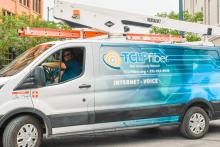
The California Public Utilities Commission (CPUC) is poised to include new broadband affordability requirements as part of the state’s looming approval of Verizon’s massive $20 billion merger with Frontier Communications, even as some consumer advocacy groups worry the changes may not go quite far enough to hold Verizon accountable.
The CPUC’s Public Advocates Office has struck a partial settlement with Verizon that the state hopes will take some of the sting out of the telecom industry’s latest consolidation spree.
Verizon’s $20 billion proposed merger with Frontier would merge two of the nation’s top four traditional phone companies, resulting in a telecom giant with assets across 31 states. The merged new company would have more than 9.6 million customers with a fiber network that ultimately passes more than 25 million fiber homes and businesses.
While the two companies don’t directly compete, Verizon’s political influence and market power will still increase. Both companies have long been criticized for lobbying to undermine U.S. broadband competition, then leveraging the resulting regional market failure to jack up consumer costs and neglecting aging DSL network upgrades and repairs.
Verizon’s latest merger was approved by the Trump FCC back in May, in exchange for promises by the company that it would back off of race and gender inclusivity efforts and purge its website of references to race and gender equality programs. Other states, like Pennsylvania and Connecticut have approved the deal with similar but notably weaker protections.

While the CPUC has yet to finalize their own approval of the deal, the Public Advocates Office’s settlement with Verizon proposes, among other things:
- Deployment of fiber-to-the-premises (FiOS) to 75,000 FCC-identified Broadband Serviceable Locations within five years of the transaction closing.
- A pledge to prioritize fiber deployment in census blocks with household incomes at or below 90 percent of county median income.
- The deployment of 250 new wireless macro cell sites within seven years not already included in Verizon’s 2026 buildout plan.
- Verizon has to offer Verizon Forward discount service for 10 years at $20 per month or lower across both its FiOS fiber and fixed wireless access (FWA) plans
The settlement also would require that Verizon participate in the California LifeLine low income broadband-only subsidy pilot and any successor program, and stack those benefits with any existing Verizon Forward discounts. Verizon must also invest $300,000 annually in outreach and advertising to raise awareness of affordability programs.
“The fiber build out itself should push the ILEC’s fiber density up to the 80th percentile of population and Verizon would have to petition the Commission – after five years – to raise the price of Verizon Forward above $20 with a detailed showing of their costs to demonstrate the need to raise prices,” Ernesto Falcon, Program Manager with the Public Advocates Office inside the CPUC tells ILSR.
The settlement, should it be formally approved, also takes an active role in shaping how Verizon will spend some of the $1.8 billion in broadband subsidies the state is expected to receive courtesy of the 2020 infrastructure bill’s Broadband, Equity, Access and Deployment (BEAD) program.
Verizon will be required to prioritize reviewing unserved/underserved BEAD-identified locations in Frontier’s footprint if they remain unserved for two years after BEAD awards. In areas where these deployments overlap Tribal jurisdictions, Verizon must make “commercially reasonable efforts to consult with Tribes about broadband needs of the sovereign territory.”
“To enforce Verizon’s commitment to investing in fiber and wireless infrastructure in California, the company must secure a $150 million performance bond to ensure compliance, file annual progress reports, and hold semi-annual consultation meetings with stakeholders,” the CPUC states.
Verizon has issued statements expressing optimism it will close its $20 billion acquisition of Frontier in the first quarter of 2026.
Settlement Comes After Lobbyists Scuttle State Affordability Bill
The CPUC settlement comes as the federal government under the Trump administration has all but abandoned broadband consumer protection and efforts to mandate broadband affordability. That leaves a smattering coalition of states as the last line of defense when it comes to ensuring affordable access, bolstering broadband competition, and protecting consumers from harm.
The settlement also comes in the wake of failed efforts to pass a new California law requiring that major California broadband ISPs provide affordable broadband access to consumers that qualify for existing low-income broadband programs.
Modeled on New York’s Affordable Broadband Act (ABA), the doomed California Affordable Home Internet Act was introduced last January. It aimed to require Internet service providers that operate in the Golden State to offer a $15 per month broadband service plan for income-eligible households.

The proposed legislation was introduced as AB 353 by Assemblymember Tasha Boerner and was initially supported by the California Alliance for Digital Equity (CADE). On June 4, the California bill advanced through the state Assembly and moved on to the state senate by a 52-17 margin.
But after passing the state Assembly, Boerner began negotiating all manner of hugely problematic changes to the bill, including the weakening of broadband speed definitions, the elimination of any serious penalties for non-compliant ISPs, and even language that attempted to strip the CPUC of any authority over broadband affordability and pricing.
The dramatic changes caused broadband equity and affordability advocates like CADE (of which ILSR is a supporting member) to end their support for the bill. Boerner then pulled the bill entirely, blaming Trump administration threats to withhold infrastructure bill BEAD subsidies from states that continue to pursue racial equity, climate, or broadband affordability initiatives.
California broadband equity organizers that have reviewed the settlement say that while CPUC’s efforts are a good start, they may not go far enough to hold Verizon’s feet to the fire.
“While the proposed settlement includes some promising infrastructure deployment and affordability concepts, we are concerned that it does not offer the necessary enforcement and accountability provisions to ensure Verizon fulfills its commitments,” Lindsey Skolnik, California CADE Manager, told ILSR.
Skolnik and CADE suggested several improvements, including more focused language preventing Verizon from jacking up the cost of service via hidden fees; tighter oversight over how Verizon’s $300,000 outreach efforts are conducted; and the banning of NDAs that risk making stakeholder meetings with Verizon less transparent to the public.
Time will tell if California’s settlements will be consistently enforced, and meaningfully balance Verizon’s lopsided monopoly power in the state (and the consistent political influence the company has over government efforts to protect consumers). California may also incur additional wrath from a Trump administration trying to scuttle market reforms.
Such collisions between a federal government that has abdicated all responsibility to ensure fair and competitive broadband pricing – and a handful of states that want to ensure consumers are semi-protected from anti-competitive telecom monopolies, will be a consistent theme over the next few years as billions in historic broadband subsidies finally wind their way to states.
Header image of California Public Utilities Commission building courtesy of Wikimedia Commons, CC BY-SA 3.0, Attribution-ShareAlike 3.0 Unported
Inline image of merger and acquisition paperwork courtesy of Legal 6, CC BY-SA 3.0, Attribution-ShareAlike 3.0 Unported
Inline image of Verizon headquarters in NY courtesy of Wikimedia Commons, CC BY-SA 3.0, Attribution-ShareAlike 3.0 Unported







